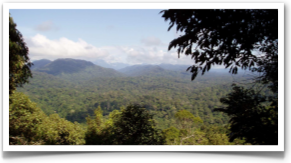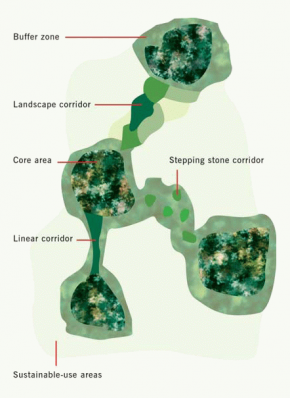Sicirec - Definitions
Ecological corridors and biodiversity
What is biodiversity?
Biodiversity is a contraction of "biological diversity".
According to the Oxford dictionary, biodiversity stands for 'the multitude of animal and plant species'.

This diversity refers both to the variety of life forms within a certain ecosystem as well as the genetic diversity in these species.
Biodiversity depends on environmental and climatic circumstances and the ability of organisms to adapt to these.
Why is biodiversity important?
Like other species, mankind and her environment depend on nature for countless matters. Food, water, and medicines for example, are ingredients taken from nature which we require in our daily lives.
Especially in our food production, our dependance on nature is apparent
Threats to biodiversity
Formerly, ungoverned hunting, poaching, collecting, and prosecution were important causes for the decline of animal and plant diversity.
Today one of the large threaths to biodiversity is the fragmentation of nature reserves. Large scale clearing of primary forest and expansion of the agricultural acreage are most to blame for this.
The harmful results of fragmentation are worsened by increased acidity, over-fertilization and drought, as these cause a further decline in the quality of the remaining habitat.
What does an ecological network look like?
Ecological networks consist of core areas, corridors and buffer zones. Corridors create a permanent connection between core areas.
The core areas and connecting corridors are surrounded by buffer zones which serve as a protection from possible disruptive external influences.
Beyond the core areas and connecting corridors lies another area with land selected for sustainable use with preservation of several ecosystem functions.

What is the purpose of ecological corridors?
Corridors help maintain or recover a certain degree of cohesion in otherwise fragmented ecosystems.
Through the connection of fragmented habitats, the viability of animal and plant species is improved by:
- enlarging habitats, for example to improve the search for food,
- dispersion of young animals,
- re-use of "empty" habitats.
Because of climate change, the borders of suitable habitats are continuously changing. Because of that, it's important for many species to be able to migrate over great distances.
Which animal and plant species disappear?
Mainly non-migrating species, depending on a specific food supply, are vulnerable to fragmentation of their habitat. Additionally, species depending on vast habitats, such as large mammals, are vulnerable.
A viable population of these species can not be provided for in small-scale habitats.
Mainly forest animals and plants are threathened in their existance as a result of fragmentation.
What can be done against fragmentation?
In order to counteract fragmentation, the establishment of ecological interconnecting corridors is important.
The idea to establish corridors started to develop over 30 years ago. Currently, research is being performed worldwide to find the best manner of including ecological corridors in the landscape on a regional, national and international level. This research is meant to strengthen the interconnection of habitats.

By connecting neighbouring nature reserves (core areas) through corridors, a network of natural areas, or 'ecological network', is created.
What does a corridor look like?
Roughly, three types of corridor can in general be distinguished. These are:
- linear corridors; these are long, uninterrupted strips of vegetation, such as hedges, strips of forest, and the vegetation growing on banks of rivers and streams;
- stepping stone corridors; a series of small, non-connected habitats which are used to find shelter, food, or to rest;
- landscape corridors; these consist of diverse, uninterrupted landscape elements which offer sufficient cover for a safe journey from one core area to another.
In light of their purpose, core areas and corridors should be free of human exploitation
What does a buffer zone look like?
Although the concept of a buffer zone is simple, the establishment requires thorough research. A certain measure of human exploitation is possible in a buffer zone.
To determine which type of exploitation is suitable, knowledge of the complex dynamics between human activities and flora and fauna is required. The exploitation should in no way be detrimental to the nature preservation of core areas and corridors.
For additional information you may read: Conservation of Biodiversity.

